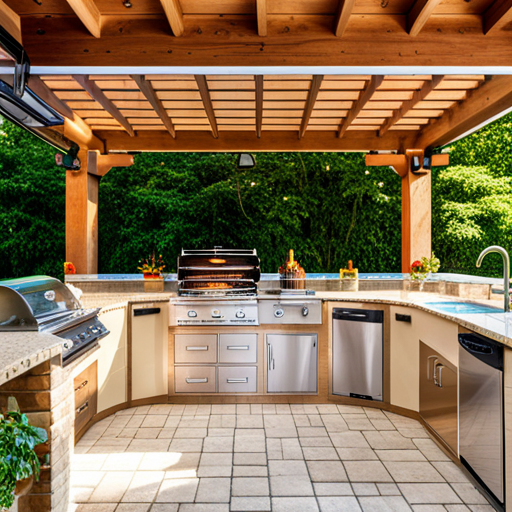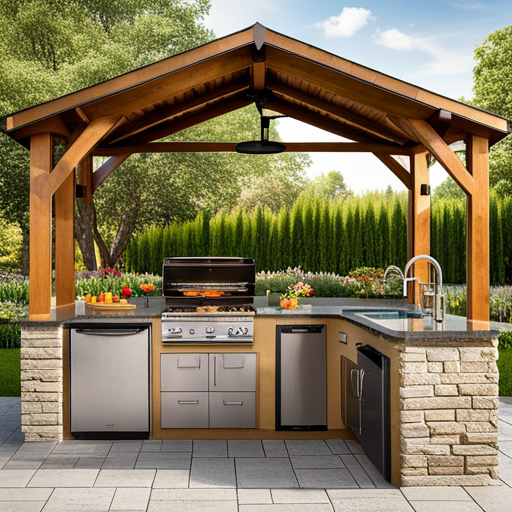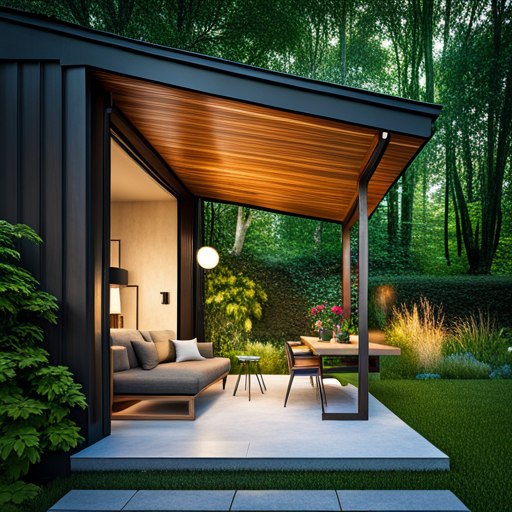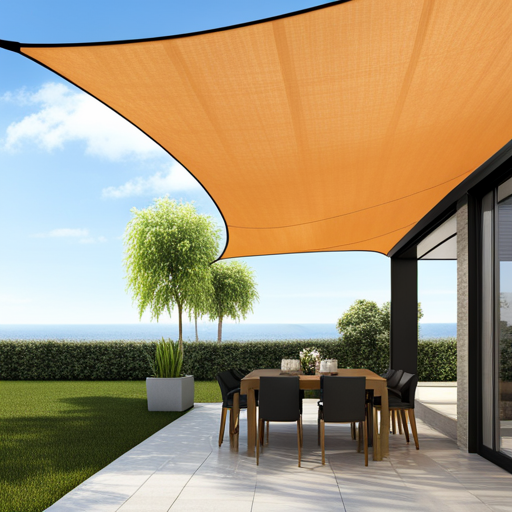Last Updated on June 25, 2024 by John Coleman

If you purchase through links on this site, we may earn a small commission. See our affiliate disclosure.
Selecting the perfect task lighting for your outdoor spaces isn’t just about convenience—it’s a critical step in enhancing functionality, ensuring safety, and crafting the ideal ambiance. Whether you’re tending to your garden as the sun sets, grilling after dark, or embarking on other nocturnal projects, choosing the right lighting transforms these activities into both enjoyable and productive ventures. Beyond mere practicality, thoughtful lighting design creates a warm and welcoming atmosphere. Choosing the best lighting can turn a good outdoor space into a great one.
What is Outdoor Task Lighting?
Outdoor task lighting refers to the use of lighting fixtures and systems specifically designed to illuminate specific outdoor areas or tasks. It is an essential element in outdoor design, as it not only enhances the aesthetic appeal but also provides practical benefits.
Task Lighting vs. General or Ambient Lighting
Task lighting is different from general or ambient lighting. General lighting (AKA ambient lighting) is used to provide overall illumination in a space while task lighting serves a specific purpose and is meant to light up a particular area for performing certain tasks. In outdoor spaces, general lighting may not be sufficient to properly illuminate areas where activities such as cooking, reading, or entertaining take place. This is where task lighting comes in handy.
Benefits of Outdoor Task Lighting
- Enhanced Safety: Outdoor task lighting improves visibility in areas such as walkways, steps, and around pools or decks, reducing the risk of accidents and injuries.
- Increased Security: Well-lit exteriors can deter potential intruders by eliminating dark areas that may hide unwanted visitors.
- Improved Aesthetics: Strategic lighting can highlight landscaping features or architectural details, enhancing the property’s visual appeal at night.
- Extended Outdoor Usage: With adequate lighting, outdoor spaces can be enjoyed even after the sun sets, extending the time families can spend in their outdoor living areas.
- Energy Efficiency: Modern outdoor task lighting options include LED and solar-powered fixtures, offering cost-effective, environmentally friendly solutions for illuminating outdoor spaces.
How Much Does Task Lighting Cost?
The cost of outdoor task lighting depends on various factors, such as the type and number of fixtures, installation fees, and ongoing maintenance. On average, homeowners can expect to spend anywhere from $200 to $2,000 for basic outdoor task lighting. For more elaborate setups with high-end fixtures and professional installation, the cost can range from $3,000 to $10,000 or more. However, the long-term benefits and added value to the property make it a worthwhile investment for many homeowners.
Choosing the Right Outdoor Task Lighting
When selecting outdoor task lighting, consider the following factors:
- Purpose: Determine what areas need to be illuminated and for what purpose. This will help determine the type and placement of lighting fixtures.
- Power Source: Consider if there is an accessible power source nearby or if solar-powered options would be more suitable for your outdoor space.
- Style: Choose lighting fixtures that complement the overall style of your home and outdoor space. For example, traditional lantern-style path lights may not look as cohesive in a modern landscape.
- Durability: Outdoor lighting fixtures should be able to withstand various weather conditions and elements. Look for fixtures made from durable materials such as aluminum or stainless steel.
- Energy Efficiency: Opt for LED or solar-powered options to save on energy costs and reduce your environmental impact.
Types of Outdoor Task Lighting for Each Area of Your Space
Countertops and Food Prep Areas
These fixtures provide direct illumination to make slicing, dicing, and cooking easier and safer. These areas would benefit from options such as:
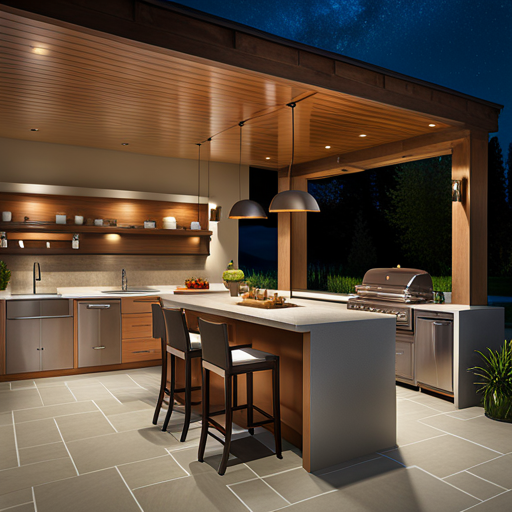
- Under-Cabinet Lights: Mounted under cabinets or shelves, these lights provide bright, focused illumination directly on the countertop, making it easier to see fine details while prepping food.
- Pendant Lights: Ideal for hanging over larger food prep areas or kitchen islands, pendant lights add both style and function by offering ample lighting from above.
- LED Strip Lights: These can be easily adhered underneath or above cabinets and along the edges of countertops for a continuous, even light spread across the work surfaces.
- Adjustable Track Lighting: Allows for customizable lighting positions, making it perfect for targeting specific areas of the countertop or food prep zone with precision.
If you purchase through links on this site, we may earn a small commission. See our affiliate disclosure.
Grilling and Cooking Areas
Overhead or flush-mounted fixtures can be beneficial for grilling and cooking areas, providing adequate lighting for nighttime use. These fixtures should be weatherproof and designed to withstand heat and smoke. Lighting for these areas would include:
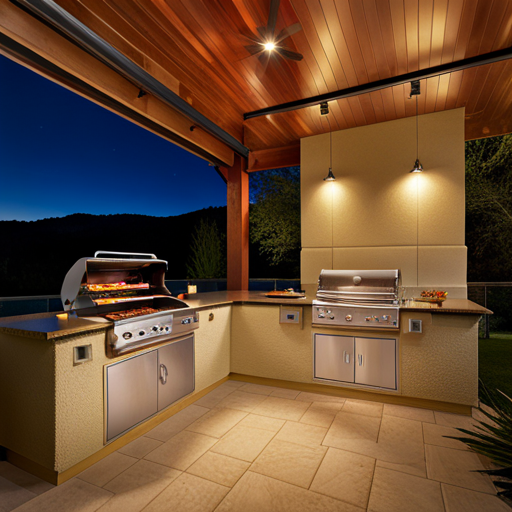
- Overhead Lights: Designed to cast a wide range of light over the entire grilling area, making it easier to see the grill surface and surrounding workspace.
- Wall-Mounted Lights: Fixed at strategic points around the cooking area to illuminate specific zones without taking up work surface space.
- Portable LED Lights: Can be moved and adjusted as needed, offering flexibility to direct light exactly where it’s required, especially useful for grilling after dark.
- Magnetic Task Lights: Attach directly to metal surfaces of grills or smokers, providing focused light right where it’s needed without permanent installation.
Dining and Seating Areas
Task lighting is used in dining and entertainment areas to create a cozy ambiance. These fixtures provide soft, warm light that is perfect for creating a relaxed atmosphere. Examples of this type of lighting would be:
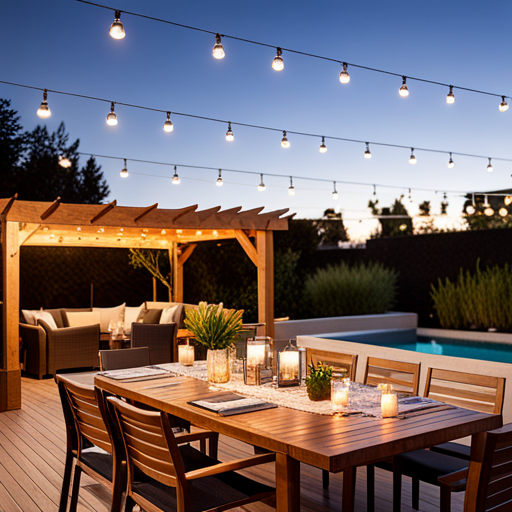
- Ceiling Fans with Lights: Ideal for illuminating both indoor and outdoor dining areas, providing a dual function of lighting and cooling.
- String Lights: Create a charming and welcoming atmosphere for outdoor dining or seating spaces. These lights can be strung across pergolas, umbrellas, or trees for added charm.
- Recessed Lights: Can create seamless lighting in the ceiling above a dining area, without taking up any visual space.
- Table Lamps: Placed on side tables or buffet tables, these fixtures offer soft task lighting that can be easily adjusted as needed.
- Pendant Lights: Can be hung above a dining table to create a focal point while also providing ample light for eating and entertaining.
- Floor Lamps: Offer a soft and warm glow for seating areas, adding both ambiance and task lighting.
- Lanterns: Placed on tables or along pathways, providing mobile and atmospheric lighting.
- Wall-Mounted Sconces: Fixed to walls or fences, offering a soft glow that enhances the area without being overpowering.
- Fire Pits and Candles: Serve both as a light source and a heat source, creating a cozy, inviting atmosphere.
Pathways and Steps
To ensure safety and visibility, include lighting along pathways and steps leading to your outdoor area. Below are some options that enhance visibility and aesthetics. For pathways and steps you might utilize:
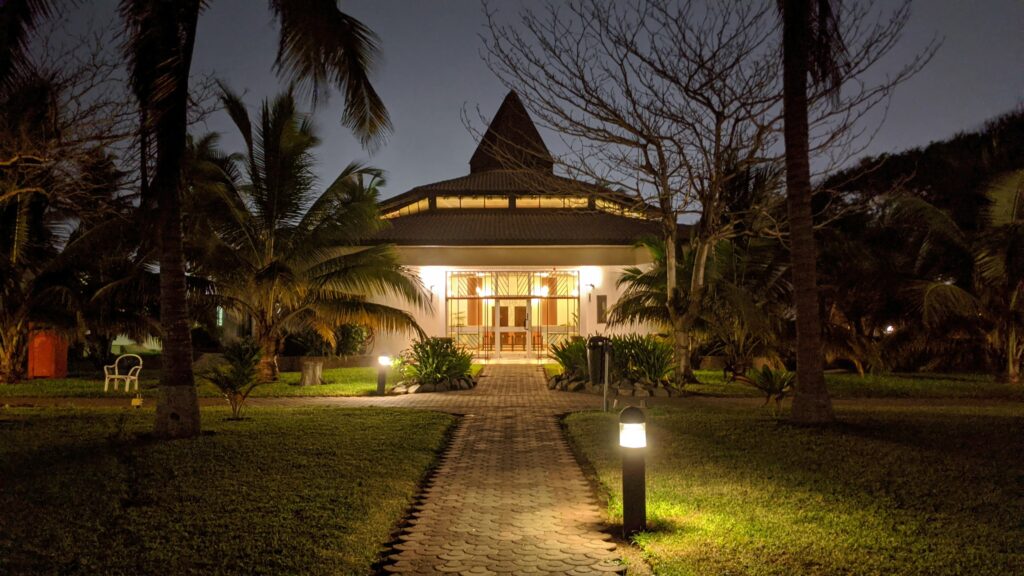
- Solar-Powered Stake Lights: Ideal for pathways, they charge during the day and illuminate automatically at dusk, providing a hassle-free lighting solution.
- Low-Voltage Path Lights: Offer a more consistent source of light along pathways, requiring a transformer but yielding a reliable, ambient glow.
- Recessed Step Lights: Installed into the steps themselves, these fixtures provide a sleek look while ensuring each step is safely lit.
- LED Pathway Markers: Durable and energy-efficient, these markers light up walkways and landscape boundaries with clear visibility.
- Landscape Lighting: Can be directed along pathways and steps, providing both functional and decorative lighting.
- Flood Lights: Added security and visibility can be achieved with strategically placed flood lights along paths and steps.
Watts vs. Lumens
When considering outdoor lighting options, it’s important to understand the difference between watts and lumens. Watts measure the amount of energy used by a light source, while lumens measure the brightness or intensity of the light produced. In traditional incandescent bulbs, higher wattage meant brighter light, but with advancements in LED technology, lumens have become the more reliable measurement for brightness. When choosing outdoor lighting, look for lumens rather than watts to ensure the desired level of brightness and energy efficiency.
How Many Lumens (Brightness) Should Task Lighting Be?
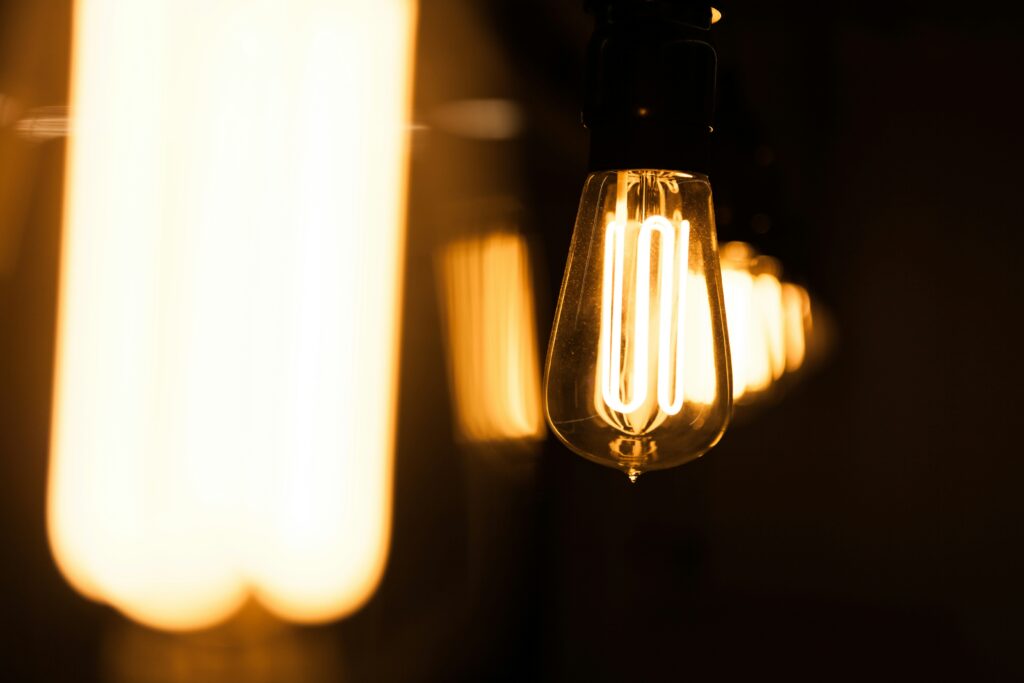
Task lighting in outdoor areas requires careful consideration to balance functionality with ambiance. Ideally, task lighting should be bright enough to safely perform specific activities without causing glare or discomfort. A brightness of at least 75-100 lumens per square foot is recommended for most outdoor task lighting situations, such as cooking areas or workspaces. This level ensures sufficient illumination for tasks without being overly harsh.
Comparatively, ambient lighting is designed to provide a soft, overall light to an area, enhancing visibility and safety with a welcoming glow. Ambient lighting typically requires a lower brightness level, around 20-50 lumens per square foot, depending on the specific outdoor setting and the desired mood.
Accent lighting, on the other hand, focuses on highlighting architectural features, plants, or sculptures, and generally operates at a lower brightness of around 10-20 lumens per square foot which is less than task lighting. It’s used to create visual interest and draw the eye to specific areas, rather than to illuminate spaces for practical use. Accent lighting often employs a narrow beam of light with an intensity that complements the overall lighting scheme without overpowering it, aiming for a balance that enhances the beauty of the outdoor space while maintaining its functionality.
How to Calculate Lumens Per Square Foot
The formula to figure lumens per square foot is:
Total Lumens Emitted / Square Footage of Area Illuminated = Lumens Per Square Foot
Let’s take a look at this further in the examples below:
Example 1 1: If you have a single lighting fixture that emits 1000 lumens and covers an area of 10 square feet, then it would have a brightness level of 100 lumens per square foot (1000/10 = 100).
Example 2: Let’s say you have five lighting fixtures that each emit 1000 lumens, you would add the total number of lumens from each fixture which would equal 5000. If the space being illuminated is 50 square feet, then you would divide the total number of lumens (5000) by the number of square feet (50) which would give you 100 lumens (brightness) per square foot (5000/50 = 100).
In projects such as outdoor kitchens, it is important to envision your area as sections and the types of lighting fixtures for each section. For instance, if you are using pendant lights to illuminate your bar area, you want to take the square footage of only the bar area when figuring your lumens per square foot.
In general, the following guidelines can be used as a starting point when calculating lumens per square foot for outdoor lighting:
- Task lighting: 50-300 lumens per square foot
- Ambient lighting: 20-50 lumens per square foot
- Accent lighting: 10-20 lumens per square foot
However, these numbers are not set in stone and should be adjusted based on individual needs and preferences. It’s also important to consider factors such as the size and layout of the outdoor space, the type and intensity of light fixtures being used, and any additional sources of natural or artificial light.
It’s recommended to consult with a professional lighting designer or electrician for a more accurate assessment and personalized recommendations based on your specific outdoor area. They can also help you select the right types of lights and determine their placement for optimal functionality and aesthetics.
Light Temperature
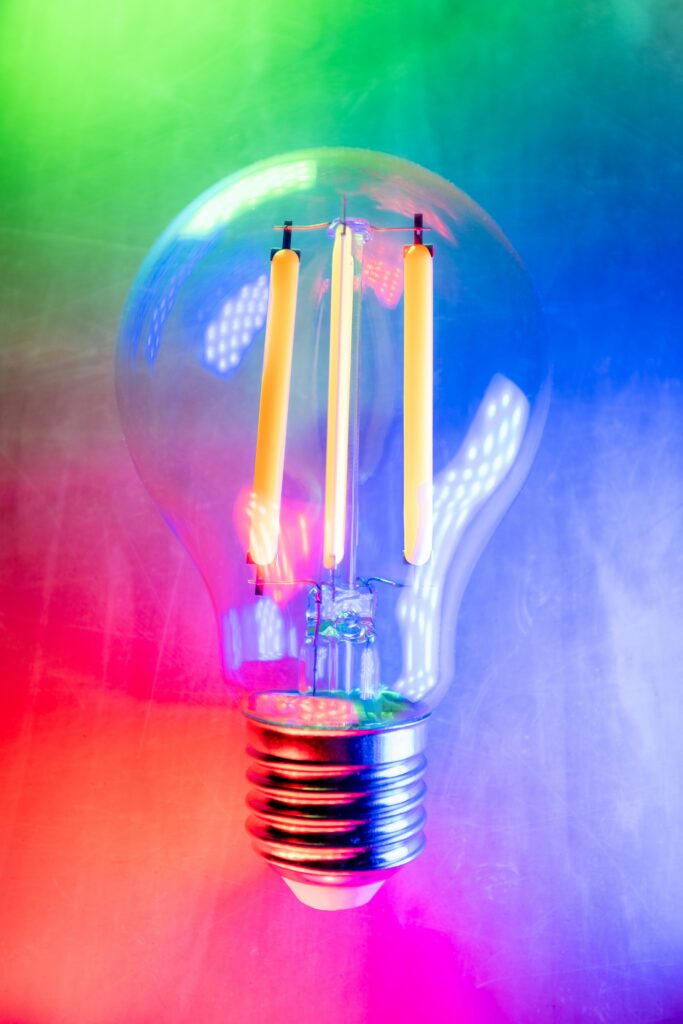
Light temperature also plays an important role in outdoor lighting design. The color of light is measured in Kelvin (K), with warmer tones having lower values and cooler tones having higher values. Warmer tones, ranging from 2000K to 3000K, create a cozy and inviting atmosphere while cooler tones, ranging from 4000K to 5000K, produce a brighter and more energetic feel.
When selecting light temperature for outdoor lighting, it’s essential to consider the purpose of the space. For areas intended for relaxation and entertainment, warmer tones are more appropriate as they create a comfortable and welcoming ambiance. On the other hand, for task-oriented spaces such as outdoor kitchens or work areas, cooler tones may be more suitable to provide ample lighting for specific tasks.
Dimmer Switches for Task Lighting
In addition to proper wattage and light temperature, incorporating dimmer switches for task lighting can greatly enhance the functionality of an outdoor space. Dimmer switches allow for adjustable lighting levels, making it possible to create a more customized and comfortable environment. For example, during an evening gathering on the patio, you may want softer ambient lighting to set the mood. However, when cooking on the grill, you may use a dimmer switch to make the lighting brighter and then dim the lights after your finished cooking.
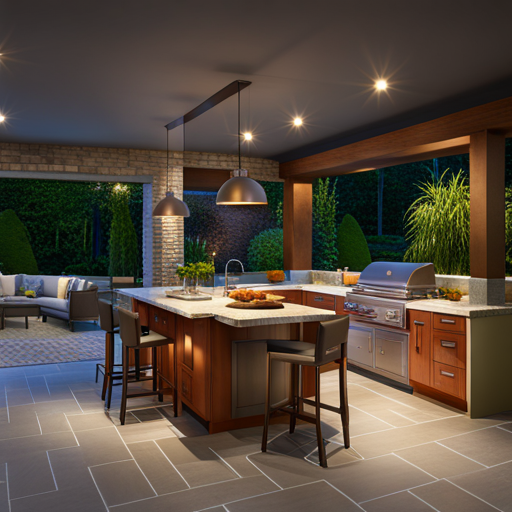
Design and Aesthetics
Apart from functionality, outdoor task lighting also serves an aesthetic purpose. It can add character and enhance the overall design of the outdoor space. Incorporating different types of lighting fixtures, such as wall sconces or string lights, can create a layered and visually appealing look. In addition, using different light temperatures and placement angles can add depth and dimension to the design. Strategic placement of lighting can also highlight specific features or focal points, such as a beautiful landscape or architectural element.
Maintenance and Safety
When installing outdoor task lighting, it’s important to consider the maintenance and safety aspect as well. Choosing durable and weather-resistant fixtures can ensure longevity and minimize the need for frequent replacements. If you are inexperienced in DIY installation of lighting, proper installation by a professional electrician is recommended to avoid any potential hazards, such as exposed wiring or overloaded circuits. Regular inspections and upkeep of outdoor lighting can prevent accidents and ensure the safety of your outdoor space.
Adding Value to Your Home

Incorporating task lighting in your outdoor space not only improves functionality andaesthetics, but it can also add value to your property and make it stand out more. Outdoor living spaces have become increasingly popular, and having well-designed and functional lighting can make your home more attractive to potential buyers. It also extends the use of your outdoor space, making it more enjoyable for you and your family. So, investing in outdoor task lighting can not only benefit your current lifestyle but also add value to your home in the long run.
Conclusion
In conclusion, outdoor task lighting is a crucial component of any well-designed and functional outdoor space. From improving functionality to adding aesthetic appeal, it serves multiple purposes. When planning for outdoor task lighting, consider the specific needs and features of your outdoor space, as well as factors such as maintenance and safety. With strategic placement and proper installation, outdoor task lighting can elevate the look and feel of your outdoor area, while also adding value to your property. So, don’t underestimate the importance of this aspect when designing or revamping your outdoor space.
If you purchase through links on this site, we may earn a small commission. See our affiliate disclosure.
Frequently Asked Questions
What types of outdoor task lighting are available?
Outdoor task lighting comes in various forms, including spotlights, pathway lights, deck lights, and under-rail lights. Each type serves a specific purpose, from illuminating walkways for safety to highlighting work areas for functionality.
How does outdoor task lighting impact energy consumption?
Proper outdoor task lighting can be energy-efficient, especially when using LED bulbs or solar-powered lights. It’s important to choose fixtures that provide adequate lighting without excessive brightness to minimize energy consumption.
Can I install outdoor task lighting myself, or do I need a professional?
While some outdoor task lighting can be installed by a homeowner, such as solar pathway lights, for more complex systems involving wiring, it’s recommended to hire a professional electrician to ensure safety and proper installation.
How do I choose the right lighting for my outdoor space?
Consider the specific tasks you want to illuminate, such as cooking areas or walking paths, and select lighting fixtures designed for these purposes. Also, take into account the style of your outdoor space to ensure the lighting complements your overall design aesthetic.
Is outdoor task lighting weatherproof?
Most outdoor task lighting is designed to be weather-resistant, but it’s important to check the product specifications for ratings such as waterproof or weatherproof to ensure the lighting can withstand your local climate conditions.
How often should outdoor task lighting be replaced?
The lifespan of outdoor task lighting fixtures varies depending on the material, brand, and type of bulb used. LED lights, for example, can last for many years. Regular maintenance and inspections can help extend the life of your outdoor lighting.


